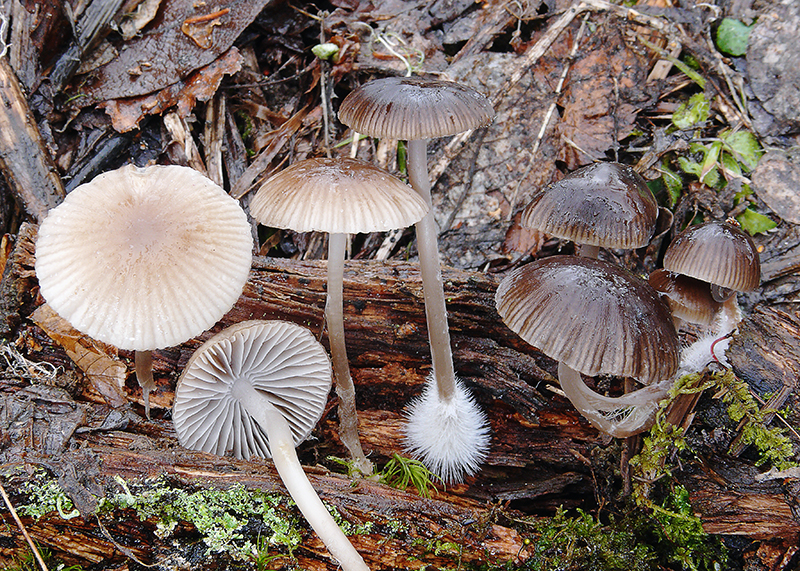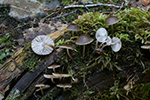|
Mycena flos-nivium
Kühner
|
Growing singly, in small groups or subcespitose on coniferous debris such as wood, bark, needles, and cones of Picea, Abies, and Pinus. A vernal species known from submontane and montane regions of France, Switzerland, the Czech Republic, Italy, Spain, Austria and Germany. Not recorded in Norway. According to Ludwig (2012) distributed but rare north to the polar circle but he provided no evidence. Pileus 8-40 mm across, convex to conical or campanulate, flattening with age., or the margin finally upturned, without or with pronounced umbo, not or shallowly sulcate, translucent-striate, minutely puberulous, very dark sepia brown or dark grey-brown to brown approaching fulvous, paler to dingy whitish at the margin, strongly hygrophanous, drying isabella or alutaceous. Lamellae 17-26 reaching the stipe, pliable-tough, ascending, adnate, decurrent with a tooth, greyish or touched with a brownish shade, pallescent or turning slightly pinkish, with age becoming spotted with reddish brown stains, edge concolorous or paler. Stipe 25-70 x 1.5-3 mm, firm but rather brittle, narrowly fistulose, straight or curved towards the base, equal or somewhat broadened below, dry, shining, glabrous for the greater part, pale greyish brown, watery whitish above, darkening below, at times dark sepia brown, the base densely and conspicuously covered with long, coarse, flexuous, whitish fibrils. Odour indistinctive or slightly farinaceous. Taste recorded as indistinct or weakly raphanoid or farinaceous. Basidia 27-40 x 7-8 μm, clavate, 4-spored (but a few 2-spored basidia seen), with sterigmata 4-8 μm long. Spores 8-11.5 x 4-5 μm, Q = 1.9-2.6, Qav = 2.1, elongated pip-shaped, subcylindrical, smooth, amyloid. Cheilocystidia 20-80 x 6-12 μm, forming a sterile band, clavate, some very long-stalked, covered with fairly few, unevenly spaced, usually rather coarse, simple to branched, straight to curved excrescences 1.5-18 x 1-2 μm. Pleurocystidia absent. Lamellar trama dextrinoid. Hyphae of the pileipellis 1.5-4 μm wide, very sparsely covered with excrescences 2-15 x 0.5-1 μm, the side-branches up to 35 μm long and usually more densely diverticulate, with a tendency to become somewhat gelatinized. Hyphae of the cortical layer of the stipe 1-3 μm wide, sparsely covered with simple to branched excrescences 2-10 x 0.5-1.5 μm, in the upper part of the stipe some very branched and cystidia-like; terminal cells up to 6 μm wide, diverticulate. Clamp connections present in all tissues. I have never seen this species, so the macroscopic description is based on Kühner (1938), Maas Geesteranus (1985) and Ludwig (2012). The microscopic details are based on examination of two French collections kindly put to my disposal by Jean-Louis Cheype and Jean-Luc Fasciotto. Mycena plumipes and M. silvae-nigrae also occur in the springtime. The former grows on picea cones, has a nitrous smell and smooth cheilocystidia; the latter grows on rotten coniferous wood but has a nitrous smell, more or less smooth chellocystidia and much broader spores. Macroscopic young specimens of Mycena maculata are rather similar but can be separated by broader spores, almost smooth hyphae of the pileipellis and not an entirely sterile lamellar edge. Besides, M. maculata generally occurs in the autumn. Sometimes M. galericulata can be found in mild winter and early spring too. It can be distinguished by a generally paler pileus, a hollow, cartilaginous, elastic tough stipe, a farinaceous taste, and broader spores. |


